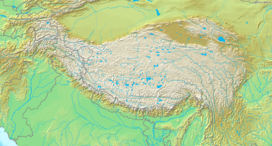K2
| K2 | |
|---|---|

K2, summer 2006
|
|
| Highest point | |
| Elevation | 8,611 metres (28,251 ft) Ranked 2nd |
| Prominence | 4,017 m (13,179 ft) Ranked 22nd |
| Isolation | 1,316 kilometres (818 mi) |
| Listing |
Eight-thousander Country high point Seven Second Summits Ultra |
| Coordinates | 35°52′57″N 76°30′48″E / 35.88250°N 76.51333°ECoordinates: 35°52′57″N 76°30′48″E / 35.88250°N 76.51333°E |
| Geography | |
| Parent range | Karakoram |
| Climbing | |
| First ascent | 31 July 1954 Achille Compagnoni Lino Lacedelli |
| Easiest route | Abruzzi Spur |
K2, also known as Mount Godwin-Austen or Chhogori (Balti: چھوغوری), is the second highest mountain in the world, after Mount Everest, at 8,611 metres (28,251 ft) above sea level. It is located on the China-Pakistan border between Baltistan, in the Gilgit–Baltistan region of northern Pakistan, and the Taxkorgan Tajik Autonomous County of Xinjiang, China. K2 is the highest point of the Karakoram range and the highest point in both Pakistan and Xinjiang.
K2 is known as the Savage Mountain due to the extreme difficulty of ascent. It has the second-highest fatality rate among the eight thousanders. With around 300 successful summits and 77 fatalities, about one person dies on the mountain for every four who summit. It is more difficult and hazardous to reach the peak of K2 from the Chinese side; thus, it is usually climbed from the Pakistani side. Unlike Annapurna, the mountain with the highest fatality-to-summit rate (191 summits and 61 fatalities), or the other eight thousanders, K2 has never been climbed during winter.
The name K2 is derived from the notation used by the Great Trigonometric Survey of British India. Thomas Montgomerie made the first survey of the Karakoram from Mount Haramukh, some 210 km (130 miles) to the south, and sketched the two most prominent peaks, labeling them K1 and K2.
The policy of the Great Trigonometric Survey was to use local names for mountains wherever possible and K1 was found to be known locally as Masherbrum. K2, however, appeared not to have acquired a local name, possibly due to its remoteness. The mountain is not visible from Askole, the last village to the south, or from the nearest habitation to the north, and is only fleetingly glimpsed from the end of the Baltoro Glacier, beyond which few local people would have ventured. The name Chogori, derived from two Balti words, chhogo ("big") and ri ("mountain") (چھوغوری) has been suggested as a local name, but evidence for its widespread use is scant. It may have been a compound name invented by Western explorers or simply a bemused reply to the question "What's that called?" It does, however, form the basis for the name Qogir (simplified Chinese: 乔戈里峰; traditional Chinese: 喬戈里峰; pinyin: Qiáogēlǐ Fēng) by which Chinese authorities officially refer to the peak. Other local names have been suggested including Lamba Pahar ("Tall Mountain" in Urdu) and Dapsang, but are not widely used.
...
Wikipedia

